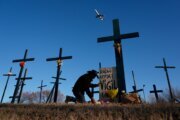GETTYSBURG, Pa. — Tourism spending is rebounding in Adams County after the area’s top industry went into a slump three years ago, one study showed.
Although an increase in the number of Gettysburg visitors likely accounts for some of that rebound in the tourism industry, there is also evidence that suggests individual tourists are spending more money as the economy improves.
In 2010, spending increased about 6.6 percent over the previous year, according to a recently released state study. The study found $555.8 million was spent in hotels, restaurants and gas stations that year. Local tourism officials are optimistic about the short-term growth.
“To see Adams County on the upswing ahead of the 150th anniversary of the Battle of Gettysburg is a promising sign,” said Norris Flowers, president of the Gettysburg Convention & Visitors Bureau, in a news release about the study.
“We will work to grow spending, employment and tax revenue well into the 150th anniversary and beyond.”
The study was commissioned by the state and measures areas of the tourism industry, including visitor spending, tax revenue, employment and wages. Conducted by the consulting company Tourism Economics located northwest of Philadelphia, the study was released this year and analyzes all 67 Pennsylvania counties.
In 2008, Adams County spending stood at $602.8 million. That fell to $520.9 million the next year, before rebounding in 2010. Although spending was still below recession levels, the firm found that in Adams County tourists spent more money as the recession came to an end.
“Previously during the recession they were guarding their wallets,” said Christopher Pike, an economist who helped complete the report. “Now they’re upgrading their free activities to paid activities.”
Pike points to specific places where tourists are spending more. The number of overnight stays in Gettysburg increased, as well as visitors’ willingness to spend money on going out to eat.
“They have a little bit more to spend,” said Pike.
The Gettysburg Convention & Visitors Bureau also believes there has been a change in travel patterns.
“People are making shorter, more frequent, visits,” Flowers said.
He believes tourists are finding more to do in Gettysburg than just see the battlefield. Repeat visitors are returning to tour other Adams County attractions such as the wineries and the apple industry. Flowers believes this is in part because of marketing efforts.
The challenge lies in identifying the difference between money spent by tourists and money spent by Adams County residents.
Researchers admit that’s not an easy task.
To determine spending levels specific to tourists, the researchers considered the relation of individual counties to the entire state. For example, if Adams County contains 1 percent of the state’s population but 3 percent of the state’s restaurant spending, researches would be able to determine that the excess can be attributed to tourists.
“If we know how the overall industry is performing at the state level, then we can get a feel for how much spending is at the local level,” Pike explained.
The study, which considered the years 2005 through 2010, found tourism spending peaked in Adams County with $602.8 million in 2008.
Adams County falls well below tourism spending in York County during these years.
Tourism spending in York County also peaked in 2008, at $829.2 million, according to the study. In 2009, spending decreased to $706.5 million, and spending in 2010 was $753.5 million.
From 2008 to 2010, overall tourism spending decreased about 9.1 percent in York County.
In both Adams and York counties, a large percentage of 2010 tourism spending went to transportation, 23 and 29 percent, respectively. That includes money spent at the gas pumps.
Visitors also spent a large percentage at restaurants that year. In Adams County, about 20 percent of total spending was at restaurants, and in York County it stood at about 23 percent.
Other 2010 visitor spending went to lodging: 13 percent in Adams County and 10 percent in York County. About 19 percent of total tourism spending went to retail for both counties in 2010.
Recreation was found to be 22 percent of total tourism spending in Adams County and 17 percent of total tourism spending in York County.
The study also found that the tourism industry created thousands of jobs in both counties.
In York County, the industry employed 7,038 people in 2010, a decrease of about 2.4 percent from the year prior.
In Adams County, the tourism industry employed 4,771 people in 2010, a decrease of about 1.3 percent.
“This is a minor decrease, something that we are confident will rebound in the coming years,” Flowers said. “We expect that the closer we get to the 150th anniversary, the more businesses will be hiring to accommodate additional customers during this commemoration.”
Editorial intern Caia Caldwell contributed to this report.







